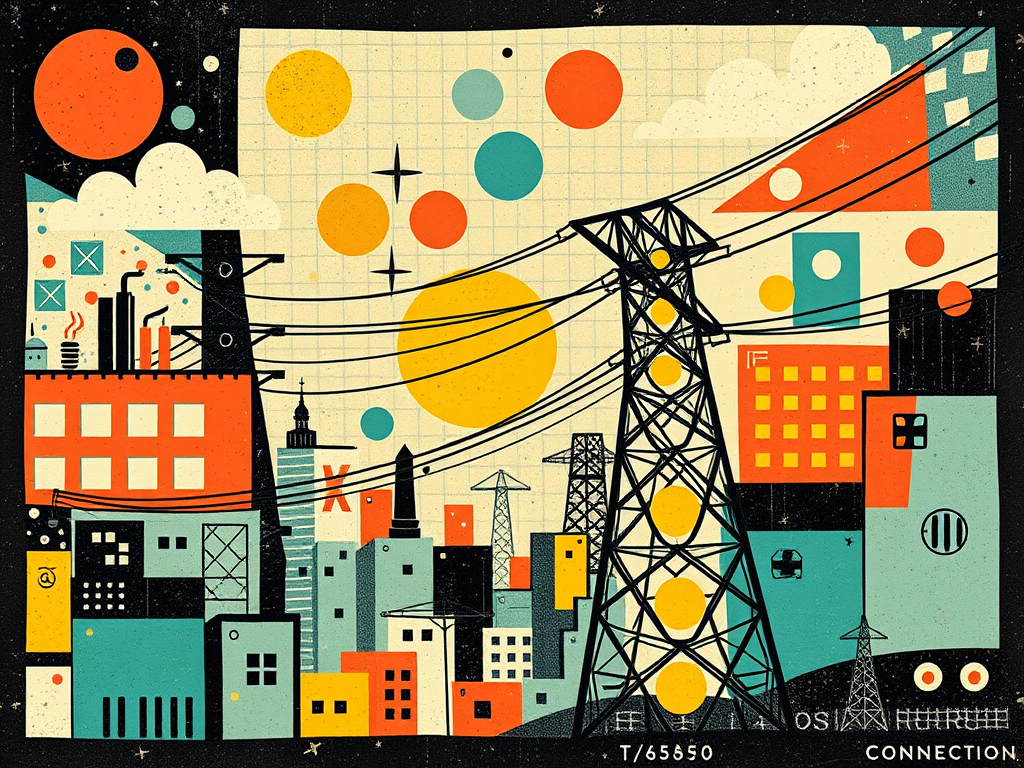
Energy Infrastructure: Grid Upgrades and Cross-Border Interconnections
Reading time: 15 minutes
Table of Contents
- Introduction
- The Current State of Energy Infrastructure
- Grid Modernization Initiatives
- Cross-Border Interconnections
- Economic Implications of Infrastructure Upgrades
- Challenges and Opportunities
- Future Outlook
- Conclusion
- FAQs
1. Introduction
As we navigate the complexities of the global energy landscape, the importance of robust and interconnected energy infrastructure cannot be overstated. This comprehensive analysis delves into the critical aspects of grid upgrades and cross-border interconnections, exploring their profound impact on economic stability, energy security, and sustainable development. By examining current trends, economic indicators, and forward-looking projections, we aim to provide a nuanced understanding of the evolving energy ecosystem.
2. The Current State of Energy Infrastructure
The global energy infrastructure is at a pivotal juncture, facing unprecedented challenges and opportunities. Aging power grids, increasing demand for electricity, and the rapid integration of renewable energy sources have created a complex landscape that requires innovative solutions and strategic investments.
2.1 Key Indicators of Infrastructure Health
To fully grasp the current state of energy infrastructure, it’s essential to examine several key indicators:
- Grid Reliability Metrics: Frequency and duration of power outages
- Transmission Capacity: Ability to handle peak loads and integrate renewable sources
- Infrastructure Age: Average age of transmission and distribution assets
- Investment Trends: Annual capital expenditure in grid modernization
- Smart Meter Penetration: Percentage of consumers with advanced metering infrastructure
Recent data reveals a mixed picture. While some regions have made significant strides in modernizing their grids, others lag behind, creating potential vulnerabilities in the global energy network.
2.2 Regional Disparities
The state of energy infrastructure varies considerably across different regions:
- North America: Aging infrastructure with increasing investment in smart grid technologies
- Europe: Progressive policies driving grid modernization and cross-border integration
- Asia-Pacific: Rapid expansion of transmission networks to meet growing demand
- Africa: Significant challenges in grid access and reliability, with emerging microgrid solutions
- South America: Diverse landscape with pockets of advanced infrastructure and areas needing substantial upgrades
These regional disparities highlight the need for tailored approaches to infrastructure development and the potential for knowledge sharing and collaborative solutions.
3. Grid Modernization Initiatives
Grid modernization is a critical component of energy infrastructure development, encompassing a wide range of technologies and strategies aimed at enhancing reliability, efficiency, and resilience.
3.1 Smart Grid Technologies
Smart grid technologies are at the forefront of grid modernization efforts. These advanced systems leverage digital communication and control technologies to create a more responsive and efficient power distribution network. Key components include:
- Advanced Metering Infrastructure (AMI)
- Distribution Automation Systems
- Synchrophasors for real-time grid monitoring
- Energy Storage Integration
- Demand Response Management Systems
The implementation of these technologies is gaining momentum globally, with smart grid investments expected to reach $61.3 billion by 2023, according to recent market research.
3.2 Resilience and Cybersecurity
As grids become more interconnected and digitalized, the focus on resilience and cybersecurity has intensified. Modernization initiatives are increasingly incorporating:
- Advanced threat detection and response systems
- Redundancy and self-healing capabilities
- Physical hardening of critical infrastructure
- Cybersecurity protocols and standards
- Workforce training and skill development in cybersecurity
These measures are crucial in safeguarding the energy infrastructure against both natural disasters and malicious attacks, ensuring the continuity of power supply in an increasingly volatile environment.
4. Cross-Border Interconnections
Cross-border interconnections represent a significant trend in energy infrastructure development, offering numerous benefits in terms of energy security, market efficiency, and renewable energy integration.
4.1 Benefits of Interconnected Grids
The advantages of cross-border interconnections are multifaceted:
- Enhanced Energy Security: Diversification of supply sources
- Improved Market Efficiency: Increased competition and price convergence
- Renewable Energy Integration: Balancing intermittent sources across larger geographic areas
- System Stability: Shared reserves and mutual support during emergencies
- Economic Benefits: Reduced need for peak capacity investments
These benefits have driven significant investment in cross-border projects, with notable examples including the European Union’s efforts to create a single energy market and the ASEAN Power Grid initiative in Southeast Asia.
4.2 Challenges in Implementation
While the potential benefits are substantial, implementing cross-border interconnections presents several challenges:
- Regulatory Harmonization: Aligning diverse national regulations and market structures
- Technical Standardization: Ensuring compatibility of different national grid systems
- Geopolitical Considerations: Navigating political sensitivities and energy sovereignty concerns
- Investment Coordination: Aligning investment plans across multiple jurisdictions
- Fair Cost and Benefit Allocation: Developing equitable mechanisms for sharing costs and benefits
Addressing these challenges requires sustained diplomatic efforts, technical cooperation, and innovative policy frameworks.
5. Economic Implications of Infrastructure Upgrades
The economic impact of energy infrastructure upgrades extends far beyond the energy sector, influencing broader economic indicators and market dynamics.
5.1 Investment and Job Creation
Large-scale infrastructure projects serve as significant economic stimuli:
- Direct Job Creation: In construction, engineering, and manufacturing sectors
- Indirect Employment: Through supply chain effects and increased economic activity
- Long-term Skilled Employment: In operation, maintenance, and related services
- Innovation Spillovers: Driving technological advancements and new industry segments
Recent studies estimate that every $1 million invested in grid modernization creates approximately 13 job-years of employment.
5.2 Energy Market Dynamics
Infrastructure upgrades have profound effects on energy market dynamics:
- Price Stabilization: Reduced congestion and improved market efficiency
- Enhanced Competition: Increased market access for diverse energy sources
- Renewable Integration: Facilitating higher penetration of variable renewable energy
- Demand Response: Enabling more active consumer participation in energy markets
- New Business Models: Emerging opportunities in energy services and virtual power plants
These market shifts are reshaping the energy landscape, creating new opportunities for innovation and investment.
6. Challenges and Opportunities
The path to modernized and interconnected energy infrastructure is fraught with challenges but also presents significant opportunities for innovation and growth.
6.1 Key Challenges
- Financing: Securing long-term funding for capital-intensive projects
- Technological Obsolescence: Balancing innovation with the need for stable, long-term solutions
- Public Acceptance: Addressing concerns about environmental impact and electromagnetic fields
- Skilled Workforce: Developing and retaining talent in rapidly evolving technical fields
- Cybersecurity: Protecting increasingly digitalized infrastructure from evolving threats
6.2 Emerging Opportunities
- Energy Storage Integration: Enhancing grid flexibility and renewable energy utilization
- Artificial Intelligence and Machine Learning: Optimizing grid operations and predictive maintenance
- Prosumer Models: Enabling consumers to actively participate in energy production and trading
- Blockchain Applications: Facilitating secure and transparent energy transactions
- Green Hydrogen: Leveraging excess renewable energy for long-term storage and cross-sector applications
These opportunities represent the frontier of energy infrastructure development, offering pathways to a more sustainable and resilient energy future.
7. Future Outlook
The future of energy infrastructure is characterized by rapid technological advancement, evolving regulatory frameworks, and shifting geopolitical dynamics. Key trends to watch include:
- Accelerated Decarbonization: Driven by policy mandates and technological advancements
- Increased Electrification: Across transportation, heating, and industrial processes
- Decentralization: Growth of distributed energy resources and microgrids
- Regional Super Grids: Large-scale interconnections spanning continents
- Convergence of Sectors: Integration of power, transport, and heating networks
These trends point towards a future where energy infrastructure becomes increasingly intelligent, interconnected, and responsive to the needs of a low-carbon economy.
8. Conclusion
The ongoing transformation of energy infrastructure through grid upgrades and cross-border interconnections represents a critical inflection point in the global energy transition. As we navigate this complex landscape, the interplay between technological innovation, policy frameworks, and market dynamics will shape the contours of our energy future.
The economic implications of these developments are profound, offering opportunities for job creation, market efficiency, and sustainable growth. However, realizing these benefits requires addressing significant challenges, from financing and regulatory harmonization to cybersecurity and workforce development.
As we look to the future, the vision of a highly interconnected, resilient, and sustainable energy infrastructure emerges as both a necessity and an opportunity. The success of this transition will depend on collaborative efforts across sectors and borders, innovative financing mechanisms, and a commitment to long-term strategic planning.
In this context, investors and policymakers should remain attuned to the evolving landscape of energy infrastructure, recognizing its pivotal role in shaping economic outcomes and environmental sustainability. As always, careful analysis of market trends, technological developments, and policy shifts will be crucial in navigating the opportunities and risks in this dynamic sector.
For those looking to diversify their investment portfolio in stable markets with potential for growth, considering property for sale in greece could be an interesting option, especially given the country’s efforts in renewable energy and infrastructure modernization.
9. FAQs
-
What is the primary driver behind grid modernization initiatives?
The primary drivers include the need to integrate renewable energy sources, improve grid reliability and resilience, and enable more efficient energy markets. These initiatives are crucial for addressing climate change goals and meeting increasing electricity demand.
-
How do cross-border interconnections impact energy prices?
Cross-border interconnections generally lead to more stable and competitive energy prices by increasing market efficiency, reducing congestion, and allowing for the sharing of energy resources across larger geographic areas. This can result in price convergence between interconnected regions.
-
What role does energy storage play in grid modernization?
Energy storage is crucial in grid modernization as it enhances grid flexibility, supports the integration of variable renewable energy sources, and provides backup power during outages. It also enables more efficient use of energy resources by storing excess energy during low-demand periods for use during peak times.
-
How are cybersecurity concerns being addressed in smart grid developments?
Cybersecurity in smart grids is being addressed through multiple layers of protection, including advanced encryption techniques, regular security audits, real-time monitoring systems, and the development of industry-wide cybersecurity standards. Additionally, there’s an increasing focus on workforce training and the integration of AI-driven threat detection systems.
-
What are the main challenges in financing large-scale energy infrastructure projects?
The main challenges include the high upfront costs, long payback periods, regulatory uncertainties, and the need to balance public and private interests. Innovative financing mechanisms, such as green bonds, public-private partnerships, and multilateral development bank support, are being explored to address these challenges.

Article reviewed by Alexandros Ioannidis, Senior Wealth Manager | Multi-Asset Portfolio Specialist | Building Customized Investment Solutions for High-Net-Worth Clients, on April 2, 2025
